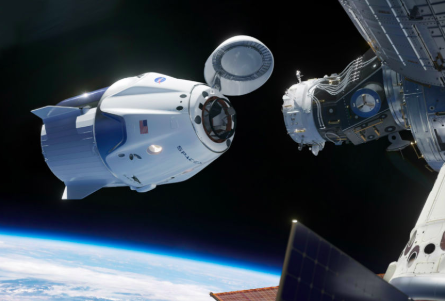SpaceX Crew Dragon Launch
March 7, 2019
Since 2011, the United States has had no independent capability for launching astronauts to the ISS. The retirement of the grand and aspiring Space Shuttle left a gap in US space capability that could only be filled by purchasing expensive, cramped seats on Russia’s Soyuz rocket. Damaging both to national pride and budget, NASA has long been searching for a way to break the Soyuz’s monopoly on human spaceflight. Now, thanks to breakthroughs by SpaceX, the promising space travel startup of entrepreneur Elon Musk, this headache may come to an end as early as this summer.
In the pitch-black, very-early-morning mist of Cape Canaveral on March 2, all lights bowed before the mighty Falcon 9 rocket as it hissed and steamed. Resting atop the rocket was the first Crew Dragon capsule to be flown. SpaceX had flown Dragon capsules to the International Space Station before, carrying supplies and equipment autonomously, but this was the first test of the platform’s capability to safely transport the more precious cargo of living crew. Although the only passenger aboard the Dragon during its early-morning launch was Ripley the mannequin, the craft proved its seaworthiness by launching, maneuvering, and docking on its own without a hiccup.
After the Crew Dragon had been secured to the ISS (docking, for the first time by any Dragon craft, without any help by the station’s massive robotic arms), the three-man crew opened its hatch to find an unharmed Ripley, reclining in possibly the most luxurious craft to ever leave Earth’s atmosphere. Complete with custom seats and blue LED ambient lighting, the interior of the Crew Dragon resembles a very small luxury passenger jet more than a spacecraft.
On March 8, after several days docked to the ISS, Crew Dragon will undock and return to Earth, testing its ability to withstand the most dangerous part of any mission—atmospheric re-entry. As spacecrafts return from space, they must slow down rapidly upon colliding with the atmosphere at orbital speeds. This generates immense pressure, heat, and G-forces and is the true test of a spacecraft’s ability to safely ferry crew. The crushing inferno of re-entry is so destructive that it’s often used to scuttle junk satellites—by dropping retired space junk into the atmosphere, space programs can incinerate even metal components into thin gas. Crew capsules from the Apollo and Mercury programs to the Shuttle have had to deal with this. It was the cause of the 2003 Shuttle Columbia disaster which killed seven astronauts. Musk has stated that he is most nervous about this segment of Crew Dragon’s mission, but if the craft’s promise so far is to be believed, re-entry will likely go well. If Crew Dragon survives re-entry and is successfully recovered, it could pave the way for astronauts to be launched from US soil once again as early as June, which would be the first time in eight years.

